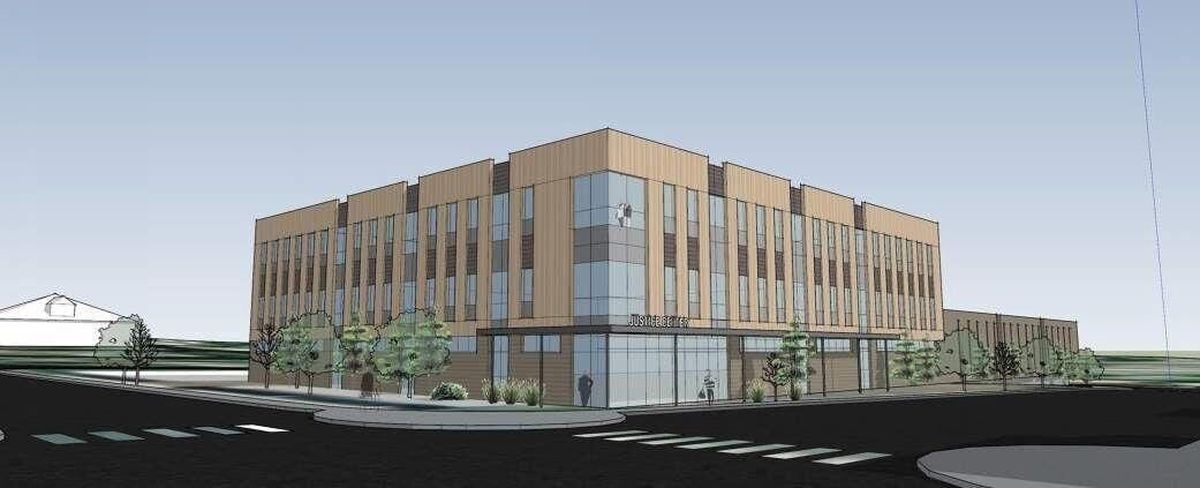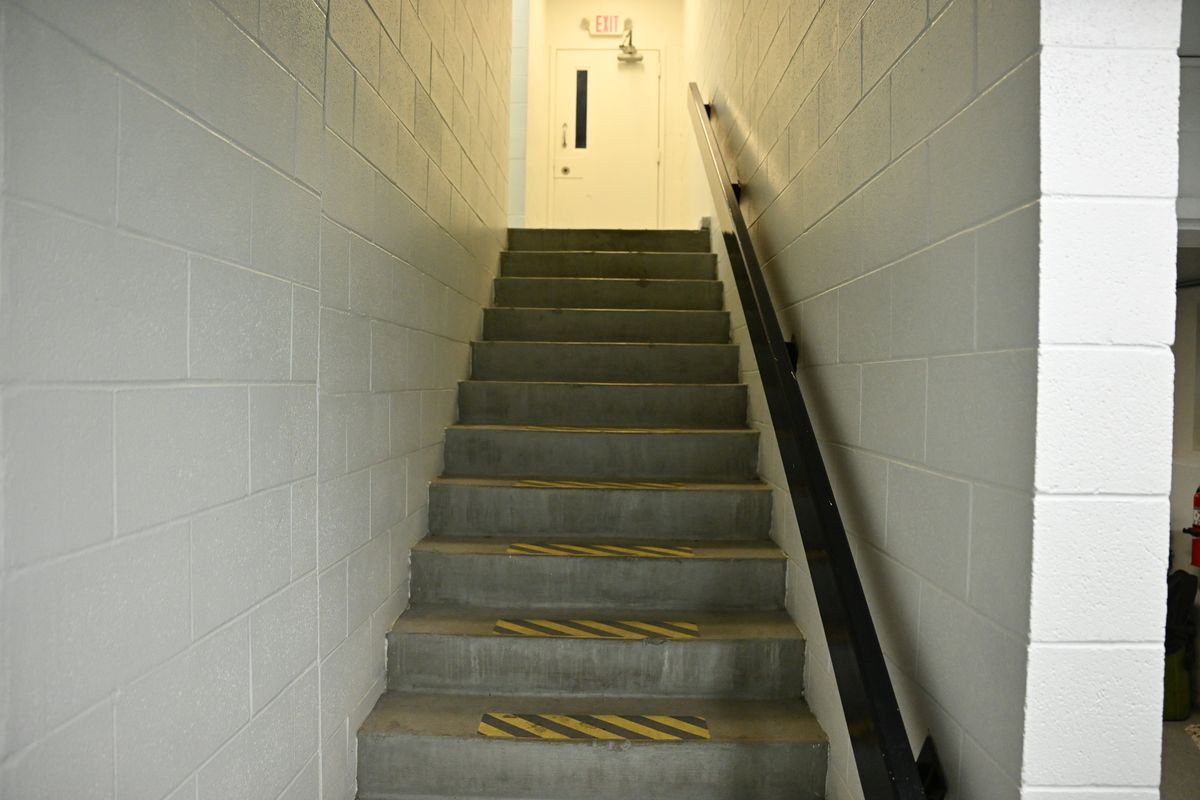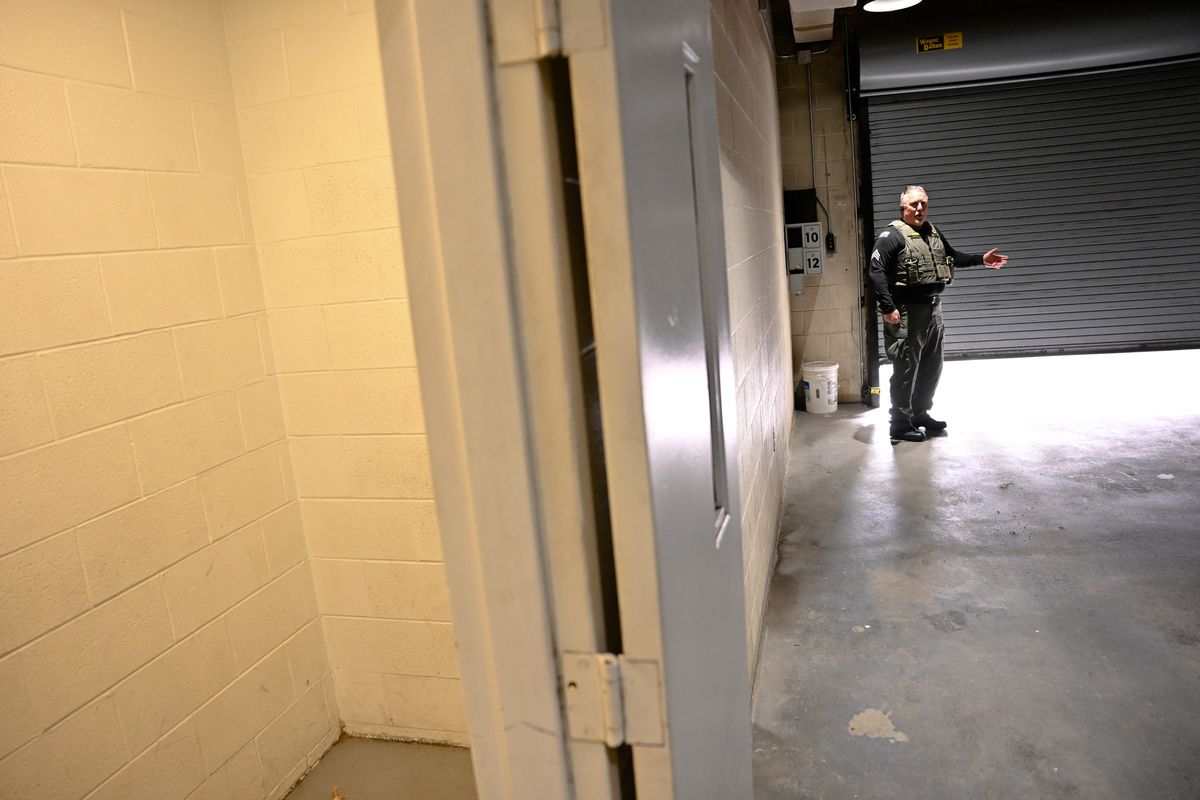Stevens County is latest to ask voters for sales tax to fund new jail
Stevens County Sheriff Sgt. Ken Niegel gives a tour of the Stevens County Jail, showing the facility’s sally port, on Tuesday in Colville, Wash. (Tyler Tjomsland/The Spokesman-Review)
COLVILLE – The Stevens County Jail, located in the basement of the courthouse, has long been overcrowded. Officials complain it’s in poor condition and poses safety hazards.
Narrow hallways and blind corners make it difficult to maneuver unruly inmates or to keep certain groups separated. Arrestees have to be escorted down a flight of steep stairs, which can be dangerous if they are intoxicated or combative.
“This has been an issue since I joined the department 27 years ago,” said Sheriff Brad Manke.
Since it is underground, there is no natural sunlight.
“The place is just horrible,” Manke said. “It’s almost a walking human rights violation.”
Like Spokane County, voters in the county directly north will decide whether to approve a sales tax to fund a new jail on the Nov. 7 ballot.
Stevens County Sheriff Sgt. Ken Niegel gives a tour of the Stevens County Jail, showing the facility’s sally port on Tuesday, Oct. 24, 2023, in Colville, Wash. (Tyler Tjomsland/The Spokesman-Review)
Manke said there was no foresight for growth when the jail was built in the early ‘70s.
“It’s not a good situation. This facility was not designed to be a jail,” said Shawn Davis, the jail superintendent.
It started with a capacity for 22 inmates and later expanded by doubling bunks. Now, inmates are often placed three to a cell, with some sleeping on floor mattresses.
In September, the jail held an average of 72 inmates a day. There were 60 on Friday.
Over the same time period since 1970, the population of Stevens County has also more than doubled from 18,000 to 48,000.
Overcrowding forces the jail to send inmates to nearby counties, which costs the county more than $150,000 a year. Typically, between eight and 16 inmates are housed in other counties at any given time, Manke said.
It also means law enforcement can’t make arrests for most misdemeanors. Those who are arrested are booked and released. There are nearly 900 outstanding arrest warrants.
And because there is no outdoor recreation area, the jail can hold inmates for no more than 90 days, per state law.
The proposed new jail would have 110 cells, with the possibility of double-bunking in the future. Manke said it should last another 50 years.
Stevens County voters will have two ballot measures to consider.
Proposition 1 asks for a 0.3% sales tax increase to help finance the costs of constructing and maintaining a new jail and justice center. Proposition 2 asks for another 0.1% “for jails and/or juvenile detention facilities.”
Separate propositions are required because they fall under two types of sales taxes.
In Washington, public safety sales taxes are capped at 0.3% and allow for a broad range of use as long as at least one third of the revenues is spent on criminal justice. Another tax capped at 0.1% can only be used for jails and juvenile detention facilities.
The county plans to use the tax exclusively for the new justice center, which would house the jail, as well as the courts and possibly the prosecutor’s office. The justice center would not include a juvenile facility, since Stevens County is a member of a collective that uses Martin Hall Juvenile Detention Center in Medical Lake.
If both propositions pass, the combined 0.4% sales tax would translate to 4 cents for every $10 spent on retail purchases by consumers in the county.
County Treasurer Leslie Valz estimates the tax would generate $3.29 million in 2024. That amount would increase slightly year-to-year with population growth and inflation.
The tax would help finance a 30-year bond so that planning and construction could begin right away. A new justice center is estimated to cost $90 million.
Listing two propositions on the ballot opens up the possibility that one could pass while the other fails.
“It is an actual concern of ours that one could pass and one could not,” Manke said.
If only Proposition 1 passes, they could still get by, Manke said, but if Proposition 2 passes and the other fails, it could be a dealbreaker.
“We really need both to pass,” Manke said. If they don’t, the propositions will likely run again on the next ballot, and the sheriff will continue public outreach.
The propositions differ somewhat from what is proposed in Spokane County, which has been criticized for not having a solid plan for how the majority of its estimated $1.7 billion will be spent.
Washington law requires counties to share 40% of public safety sales tax revenues with their municipalities on a per capita basis. Local governments have significant leeway in how to spend the money as long as it is connected to criminal justice or public safety.
Spokane County plans to use half of its share to build two new jails. But in Stevens County, each city and town has agreed to allocate their share exclusively for the justice center.
Spokane County’s Measure 1 is asking for a 0.2% increase – half as much. Still, Stevens County has one of the lowest overall sales tax rates in the state.
If the propositions passed, Stevens County would have a total sales tax of 8%, whereas unincorporated Spokane County would be 8.3% and the city of Spokane 9.2%.
Stevens County’s taxes would be permanent, whereas the Spokane County tax would sunset after 30 years. Manke said the tax will likely be needed for higher operational costs once the facility is paid for, but the commissioners could rescind the tax if they choose.
Manke hasn’t seen much public pushback against the measures, but said there is no guarantee what voters will do when they see a tax increase on the ballot.
Stevens County is reliably conservative.
Voters rejected a property tax bond measure for a new jail and courthouse in 2004. Manke said that since there wasn’t social media at the time, it was difficult to get the word out.
The three-story, 85,000 square-foot proposed justice center would be built across the street south of the current jail and courthouse, and would replace the smaller building the county commissioners now occupy.
The commissioners would switch places and move into the current courthouse, while the basement jail would likely be used for storage.
The new jail would occupy the first floor and part of the second floor. The courts would occupy the remainder of the second and third floor.
A secure elevator from the jail to the courts would prevent corrections officers from having to escort inmates through the courthouse among the public, as they do now. This creates situations where an inmate can run into their victim, Davis said.
The Shoshone County jail in North Idaho recently lost certification from the Idaho Sheriffs Association due to overcrowding.
There is no equivalent oversight for jails in Washington. However, the Legislature will soon consider a proposal from The Joint Legislative Task Force on Jail Standards to establish such an agency.
Manke said the Stevens County Jail would fail based on the draft of standards. If the jail had to close, the nearest facility that could take all of the inmates would be at least four hours away.
In the meantime, the officers are doing their best with the situation.
“Right now, for what we have, we operate as safe as we possibly can,” said Sgt. Ken Niegel, a senior corrections officer.





